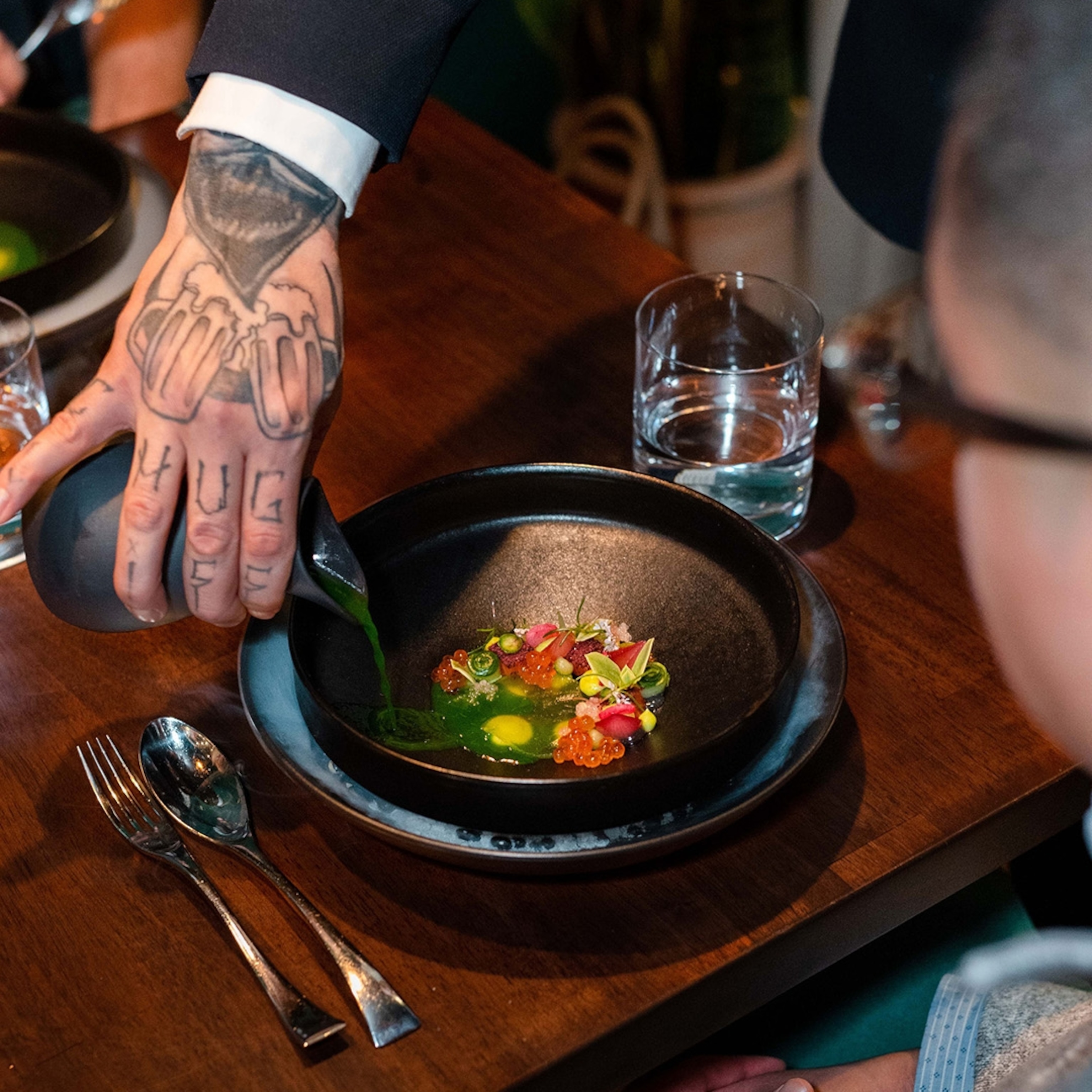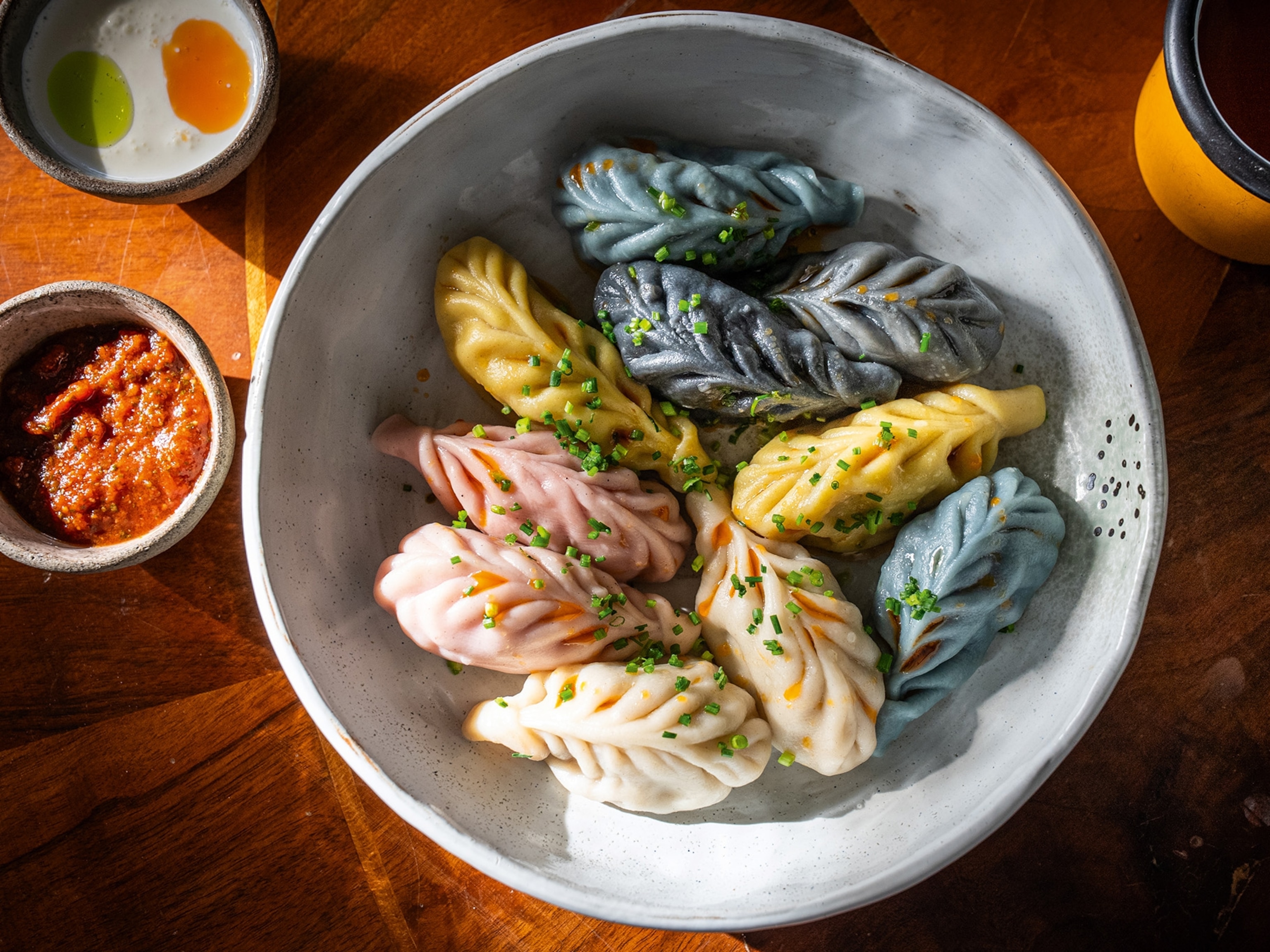
Fat Rice and rum pearls: Where to eat in Chicago
It might still be known for its deep-dish pizza but contemporary Chi-Town cuisine is focused on fresh flavours, fine dining and ambitious ideas.
Critics love: Fat Rice
Generally, my approach to food is: the more inventive, the better. But the best thing I eat in Chicago does, at first glance, give me pause. This riff on a Rice Krispies treat comes covered in pork floss, sprinkled with chilli and seaweed, and drizzled in fish-sauce caramel. Yes, fish-sauce caramel.
The Macanese rice crisp is just one of a trayful of curiosities I try at The Bakery at Fat Rice, a spunky Portuguese-Asian mash-up, where a painted pastel de nata radiates sunbeams over the entrance, while inside, brightly coloured Chinese bird cages house bare bulbs.
I also have a Ceylon tea cookie stuffed with salted egg yolk — a roller coaster of flavour, dipping between bitter tea and sugary dough — and miso fudge brownies; their rich, gooey glory elevated by a gutsy punch of umami. Still, it's the rice crisp that'll linger in my memory. Marrying this many tastes and textures, and making it work? Those are formidable skills.
I'm not alone in that opinion. Shortly after my visit, Fat Rice's chef and co-owner, Abe Conlon, won the 2018 James Beard Award for Best Chef: Great Lakes; although not well-known outside the US, the Beards are the Oscars of the food world. That Fat Rice's fusion cuisine is considered a bastion of Chicago dining suggests the city's come a long way from old-school hot dogs and deep-dish pizzas.
"We were definitely scared people wouldn't come," Fat Rice's co-owner, Adrienne Lo, tells me, acknowledging that the restaurant (now with bakery attached) wasn't an obvious candidate for culinary success. Macanese, in theory, but really an amalgam of Asian-Portuguese influences, the cuisine is exceptionally personal. It was 2007 when Adrienne, a bohemian-looking Chinese-American, met Abe Conlon — a part-Portuguese chef from Lowell, Massachusetts, who grew up fascinated by the recipes of his home city's large Cambodian population. Their mutual love of food and travel bore a romantic relationship, then a secret supperclub, which became so popular it morphed into an illegal pop-up disguised to look like a disused antique shop.
"When we got a 'cease and desist' letter from the city of Chicago, we thought maybe we ought to open a real restaurant," Adrienne recalls with a laugh. (Its runaway success has since forced the founders to table their romance; they remain business partners as well as friends.)
The pair chose to open their restaurant in residential Logan Square, which, although overlooked by most guidebooks, is widely regarded as Chicago's best food neighbourhood. "Tourists never come here," Steve Dolinsky, the food reporter for the city's ABC 7 news channel, tells me. But, he says, the low rents have helped pioneers like Fat Rice transform from scrappy startups into cherished local institutions. He also has a theory as to why Chicago's latest crop of kitchens are so experimental: it's cheaper here than on the pulse-setting coasts, but has a big-city mindset, making it a great testing ground. "It's where Broadway tries things out first," Steve adds.
Despite this, Chicago's gastronomic scene is perhaps best known for hushed fine dining rooms such as the now-closed Charlie Trotter's (still talked about in reverential tones). Fat Rice's immediate popularity on opening in 2012, then, is perhaps because it offers avant-garde cuisine in a more approachable setting. "We wanted to create a vibe like people were coming into our home, so even though the experience was different, it felt familiar," Adrienne explains. And although the restaurant's signature, namesake dish is packed with exoticism — Manila clams, piri piri peppers, Chinese sausage, Portuguese olives, to name just a few of the ingredients — it is, she says, "comfort food" at heart. eatfatrice.com
Next-gen Chicago: Lula Cafe
Chicago was once the meat-packing capital of America, earning the city the nickname 'hog butcher for the world'. However, veggie-forward Lula Cafe's Saturday brunch — a Chicago institution — rebels against the entrenched steakhouses and old-school Italian delis serving beef sandwiches. And the spring onion grits — creamy white corn pudding engulfed in a zingy tomatillo sauce, heaped with sweet onions and tart green olives — is hands-down the best brunch I've eaten all year.
Lula invented the Logan Square scene, opening in 1999 in cramped premises with a battered 1960s stove. Chef-owner Jason Hammel is credited as the man who brought farm-to-table to Chicago — a year living in Italy, he says, ignited a passion for local, seasonal ingredients — and the Lula menu changes weekly; mine has today's date stamped on it in lime green.
Chicagoans can't get enough of these fresh flavours: the sunny patio is heaving this morning, and inside, amid the crown mouldings, exposed pipes and pendant lights, there's a long wait. Having blazed a bohemian trail, the rest of the neighbourhood has followed Lula's lead, transforming it into the sort of place where independent cinemas and bookstores reign over chains. Not every venture has succeeded, though; around the corner, I spot a gutted mezcaleria and a shuttered hipster diner.
Lula, which celebrates its 20th birthday next year, may not be a vegetarian restaurant — the breakfast sandwich with house-made porchetta, crispy leeks and walnut aioli has me rolling my eyes heavenwards in ecstasy — but the vegetables really sing; sour-sweet beets on bruschetta with smoked pecans and whipped goat's cheese, in particular. If Jason is king of next-gen Chicago food, then long may he rule over us.
Mexico meets Midwest: Quiote
Named for the fat, asparagus-like stalk that shoots from the centre of an agave plant, Quiote is often billed as a mezcal bar — but it's the quasi-Mexican small plates here that make my head spin. When Dan Salls — a chef from the Chicago suburbs with regulation hipster beard and baseball cap — moved into this Logan Square spot, he inherited a wood-fired pizza oven from the previous owners. And so he incorporated it into his repertoire.
With executive chef Ross Henke now at the helm, the restaurant continues to make use of that oven; the best dish I try is a blackened wedge of roasted cabbage, served on a slick of burnt sourdough purée. The latter is thick, grainy and ink-black — a sort of liquefied, singed toast, lending extra depth to the lightly scorched veg.
Traditional Mexican food was the inspiration for Dan's culinary career (he has admitted to religiously watching Chicago-based chef Rick Bayless's TV series Mexico: One Plate at a Time before quitting a white-collar job to start a taco truck). Yet the style at Quiote can't be pigeonholed, perhaps because Dan is self-taught, or maybe it's thanks to Rick taking his ideas ad running with them.
There's a breezy freedom about the invention the chef brings to the kitchen, and the direction he takes from Midwest ingredients from the local farmer's market. In step with the area, Quiote serves its elevated cooking in a casual setting — and at a refreshingly reasonable price (from $10/£7.60 per plate). I'd pay far more for food this good — scallops in a creamy jamon foam is one of the triumphs here — not to mention the mezcal-spiked cocktails.
Wash it all down: The Aviary
Based in the trendy West Loop — Chicago's former meat-packing district, where you'll find Google's Midwest HQ in a former fish market and an Ace hotel in a converted cheese factory — The Aviary has been pushing the limits of what a cocktail bar can be since 2011. For starters, this bar doesn't have a bar. When the bouncer ushers me in — following an elaborate earpiece-and-iPad routine — I'm directed to a standing table next to the 'cocktail kitchen' (separated from drinkers by a birdcage-style steel mesh). It's actually more like a laboratory, with a team of 'drink chefs' fussing over bubbling and steaming potions — there are even three full-time 'ice chefs'. Alongside a la carte libations, there are options paired with small plates, and a seven-course food and cocktail tasting menu at $195 (£149).
The man behind all this is Grant Achatz, the chef and co-founder of Chicago's only three-Michelin-starred restaurant, Alinea, which blurs the line between art and food. The Aviary is cut from the same cloth; for example, drinkers are asked to stick their head in a bag to inhale the cocktail (719)26-OATES. I try the slightly less dramatic Jungle Bird. A lesson in liquid density, it comprises layers of rum, Campari and pineapple syrup, spotted with rum-filled pearls. theaviary.com
Outdoor eats: Maxwell Street Market
A carnival of Latin cuisine in Chicago's Near West Side every Sunday, Maxwell Street Market transports me to Mexico. Stalls sell everything from nanche (a sour-ish yellow fruit with a furry texture and cheesy scent) to shocking-green guaje ('Mexican garlic'). Then there's the street food scene: tamales, steaming Oaxacan-style in banana leaves; a man in a cowboy hat yelling about tacos and brandishing two massive knives at a hunk of spit-roasted pork. The market has been a multicultural hub since the late 1800s. In the 1940s, African-American musicians created the Chicago blues here; today, the stalls are mainly Mexican, and family-run, handed down through the generations.
Essentials
How to do it
British Airways, American Airlines and United all fly to Chicago from Heathrow, while Norwegian flies from Gatwick.
Ace Hotel Chicago offers industrial-chic accommodation in the West Loop, from $158 (£121), room only.
Kimpton Gray Hotel is a high-end option downtown, from $232 (£178), room only.
For more information, visit choosechicago.com
Published in Issue 3 of National Geographic Traveller Food






